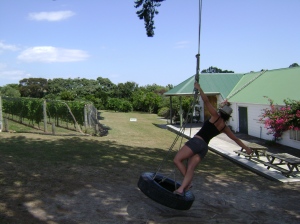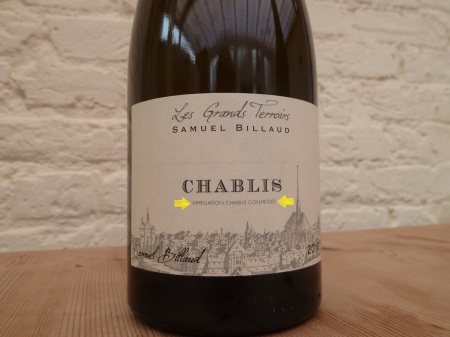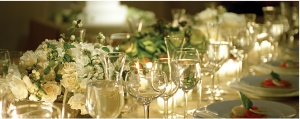 New Zealand’s North Island has been suffering the worst drought since World War 2, so much so that it has made headlines throughout the world. The majority of this year’s agricultural crops are said to be a write-off, the government has stated that it will likely cost the country NZ$2 billion, yet the wine industry is toasting what could be its most successful growing season yet. How is it possible that the grapes are going gangbusters in the face of such a severe water shortage?
New Zealand’s North Island has been suffering the worst drought since World War 2, so much so that it has made headlines throughout the world. The majority of this year’s agricultural crops are said to be a write-off, the government has stated that it will likely cost the country NZ$2 billion, yet the wine industry is toasting what could be its most successful growing season yet. How is it possible that the grapes are going gangbusters in the face of such a severe water shortage?
Posted in In the vineyard, Wine | Tagged 2013 vintage, Drought, Grape, Hawke's Bay region, Matakana, New Zealand, North Island, Vine, Waiheke Island | 1 Comment »
In my last post I wrote about how the close link between your memories and your sense of smell is key to your ability to describe wine. So whether you have had lots of experience with wine or not, it’s time to put your nose in a glass and your memories to work. Here are seven tips on how you can start developing your skills, and begin identifying a wine’s characteristics like the pros do.
1. Know the importance of smelling the wine: You may well know that flavours are largely experienced through sense of smell. Your mouth is more useful in experiencing textures, sensations, and basic flavours like salty, sweet, bitter, etc. It is an obvious one but take the time to sniff out a wine and get acquainted with delicate nuances before you tip it back.
2. Taste two wines, of the same colour, side by side: By comparing them directly, you will be able to move past a wine smelling like wine. You will find that one is fruitier, one is more intense, and one has a longer finish (sensations and flavours of the wine that you can still sense after you swallow. A long finish also indicates higher quality…more about that in another post).
 3. Reference an aroma wheel: It is likely that you will smell something familiar when nosing a wine, but without a visual reference, the words to describe the fragrance may be hard to find. An aroma wheel lists common wine odours from vague to specific. For example, if you think a wine is fruity, the wheel will help you determine if the fruit is tropical, citrusy, or dried. If you decide it is tropical, then the wheel will suggest banana, guava or pineapple (each grape variety has a typical set of characteristics. By identifying specific fruits you are progressing towards your ability to blind taste). Basically, an aroma wheel can put the words back in your mouth.
3. Reference an aroma wheel: It is likely that you will smell something familiar when nosing a wine, but without a visual reference, the words to describe the fragrance may be hard to find. An aroma wheel lists common wine odours from vague to specific. For example, if you think a wine is fruity, the wheel will help you determine if the fruit is tropical, citrusy, or dried. If you decide it is tropical, then the wheel will suggest banana, guava or pineapple (each grape variety has a typical set of characteristics. By identifying specific fruits you are progressing towards your ability to blind taste). Basically, an aroma wheel can put the words back in your mouth.
4. Don’t be shy to share your descriptions: “The wine smells like Nana’s cottage.” Sure, it is a bit nuts to describe a wine this way but that is only because no one else has been to Nana’s cottage. The trick to making sense of your descriptor is to change it into terms that others can relate too. This wine smells like Nana’s cottage, but what does Nana’s cottage smell like? Dust? Camp fire? Drift wood? Perfume? Strawberry jam? Remember this little tip and you will be a believable wine geek in no time. Whatever weird wine descriptor you come up with, there is probably a good reason for it.
5. Keep notes of what you have tasted: You may never read these notes again, but they are helpful to:
a. Organize your thoughts if you are tasting multiple wines at one time
b. Remember your first impression of a wine, and to track it as it changes. Exposure to oxygen changes the wine right in your glass. New smells will become apparent and the initial fragrances will dissipate.
c. Track similarities between wines of the same variety, region, and age. It won’t be long until you learn the difference between light pink and salmon coloured, and figure out that Sauvignon Blanc, the world over, smells like cutgrass and grapefruit.
6. Taste with friends: By bringing together different palates, and comparing notes, you will discover new ways of describing the same smell, growing your palate and diversifying your wine vocabulary. For example, what one person describes as baked bread, another person will describe as buttered toast. Don’t underestimate the importance of drinking with friends as a learning tool, especially now that you are not reluctant to share your whacky findings.
7. Visit a facility that offers a wine sensory kit, or make your own: These are a great way to start to strengthen your ability to recognise a smell and then describe it.
What methods work for you? Perhaps you have already started noticing a consistent aroma from one Cabernet to another? Feel free to share how these suggestions work for you and to offer your own tips in the comments!
Posted in Palate Training, Wine | Tagged aroma wheel, Cara De Lavallade, comparing wine, comparing wines, Grape Variety, how sommeliers taste wine, how to taste wine, Lindsay triveres, o. fournier, O. FOurnier Bodega, O. Fournier Winery, palate training, smell memories, smell memory, smelling wine, Sommelier, varietal typicity, wine aromas, wine descriptions, wine descriptors, wine flavours, wine palate training, wine tasting notes, Wine tips, wine typicity | 2 Comments »
I grew up in Northern Ontario, a region not generally thought of as one of the great wine destinations of the world. When starting out in the wine industry I knew that I had a lot to learn to catch-up with those who had a natural introduction to the vine. What I didn’t know then, was how relevant those early years were to how I experience wine now. Continue Reading »
Posted in Describing wine, Palate Training, Wine | Tagged Chardonnay, how to taste wine, Learning about wine, Malbec, Mendoza, New Zealand, Northern Ontario, palate development, weird wine smells, Wine, wine experiences, wine smells, Wine tasting descriptors | 3 Comments »
I was absolutely blown away the first time I tasted Torrontés. It had a nose of tropical fruit and flowers, not too dissimilar to that of a Gewürztraminer; but with slashes of refreshing citrus. It was intense, crisp, and richly perfumed. My experience was all that and then some. I had not been this excited about an aromatic wine since I learned how to pronounce Viognier properly! So, if you’ve been thinking about making the plunge, but haven’t yet, here are three more reasons why you should:
1. Bang-for-buck: Torrontés is generally made in stainless steel tanks and is intended to be guzzled young in order to capitalize on its fresh fruit characters. Translation: it is inexpensive to produce meaning you can expect great value for money.
2. Impress your friends with a little wine trivia: At1683 metres above sea level (5522 ft.), Torrontés shines its brightest in the world’s highest wine producing region, Cafayate, Salta in the northern reaches of Argentina’s Andes mountain ranges.
3. It’s becoming trendy and winning awards: Torrontés based wines took two top accolades at the Decanter World Wine Awards in 2011: International Trophy Dry Aromatic under 10£ and International Trophy Dry Aromatic over 10£. In the same competition Torrontés won an additional eight awards, plus five more were commended.
For those interested in developing their palates, I recommend tasting a Torrontés against aromatic wine varieties of a parallel character. Try varieties that contain the same (low) level of sweetness so that the sugar content does not interfere with the way you perceive the sweetness of the nose, the acid levels, or the texture of the wine.
Recommended wine varieties for comparisons with Torrontés are:
Riesling: Typically displays a green apple, lemon/lime, and floral nose, developing honey, toast and kerosene characters as it ages. While it consistently has high acidity, its sugar content can fall anywhere from bone dry to sticky sweet. It is also typified by its light body and low alcohol. Its homes are in Germany and the Alsace region of France, but there are great examples being produced in Austria, Australia’s Clare and Eden Valleys, Canada’s Niagara region, and New Zealand’s South Island.
Gewürztraminer: Typically displays intense floral, tropical fruit and spice aromas. Rose and lychee scents are very common, along with notes of stone fruit, musk and ginger. It is generally dry to medium-sweet with low to medium acidity. This can give the impression of high alcohol and an unctuous texture. It is one of the few varieties permitted to be grown in Alsace and it is also produced extensively in Germany; that being said, many a cool climate wine regions are having success with this variety.
Viognier: This medium to full body wine is known for its intense bouquet of dried apricot, flowers, stone fruit, and musky perfume. It generally has a high alcoholic content and a medium to full body. It is the most predominant white grape of the few produced in northern Rhone; however, curious oenologists world over are yielding good results.
I am certain that once white wine lovers wrap their laughing gear around Torrontés, they won’t be able to put the bottle down. Get ready world! Torrontés is the next hot trend in summertime wines, and will soon join Malbec as being synonymous for great Argentinian wine!
More blog post from my escapades in Argentina:
Unexpected Weather, Argentina vs New Zealand: Sauvignon Blanc and Pinot Noir, Rats in the Cellar, Wine Cellar Dinning at Azafran, Cellar Update: Here comes the Malbec , Bocce and BBQ, Vinos y Tapas at The Vines Wine Bar and Vinotecha, Mendoza Cabernet Sauvignon Compared, Training your Palate with a Wine Sensory Kit, Wine Camp is in Session, Mendoza Malbec Under $25, Winemaker Night with the team from Delmino Del Plata Estate and Susana Balbo Wines , Reporting Live from Mendoza.
Posted in Argentina, Mendoza, Typicity, White Wine, Wine | Tagged Argentina, aromatic wine, award winning wine, cafayate, cheap wine, Cosecha Mendoza, Decanter, Decanter Magazine, german wine, Gewürztraminer, Grape Typicity, Grape Variety, how to taste wine, impress your friends, Malbec, Mendoza, Mendoza Wine, palate development, palate training, quality wine, riesling, salta, summer wine, Torrontés, Tourism Mendoza, trendy wine, value wine, VArietal, viognier, what does gewurztraminer taste like, what does riesling taste like, what does torrontes taste like, Wine, Wine Awards, wine for beginners, wine of alsace, wine tasting, Wine tasting descriptors, wine trivia | 2 Comments »
I arrived in Spain in the dead of summer ready to gorge myself on everything from Rioja to Jerez. However, my quest quickly transformed into a game of ‘name that wine fault’. The majority of the wine’s defects were caused by heat, and took the form of oxidation or maderization. I think it is safe to say that poor storage conditions throughout the summer got the best of these bottles.
Oxidation can occur when a bottle’s seal malfunctions, allowing too much air to contact the wine contained within. Small amounts of oxygen, like that which passes through a cork seal, can aid in a wine’s flavor development as it ages. However, too much oxygen will cause a wine to lose intensity and smell of brown apple cores. Severely oxidized wines can develop a vinegar or nail polish remover scent. The wine will also look dull and take on a brown hue.
A maderized wine is one that has been overheated to a fault. Common causes include storage in a warm environment, like on top of a refrigerator or in direct sunlight. Named after Madera, an intentionally ‘cooked’ type of wine, it smells of nuts and caramel, similar to sherry. Albeit, not a terrible odor, it certainly is not what the winemaker intended.
Five tips to help you avoid buying heat damaged wine
1. Purchase from a reputable supplier who is likely to store and handle the wines correctly.
2. Don’t buy wine that has been stored near to any heat sources, like on top of a refrigerator, or in a window display.
3. Don’t buy wine in a shop that is subject to the heat of summer. Wine likes air-conditioning too!
4. Don’t buy a wine with a cork protruding beyond the lip of the bottle neck. Glass, wine and cork expand and contract at different rates when undergoing a change in temperature. If a bottle is subject repeatedly to abrupt temperature changes the cork will loosen, exposing the wine to oxygen.
5. Don’t buy wines if they look dull, murky, or like they are browning prematurely.
Posted in Wine | Tagged bad wine, bad wine shops, Beverages, damaged wine, green apple wine, Jerez, maderia, Maderisation, maderization, materisation, oxidation, oxidized, oxygen in wine, Rioja, sherry, Spain, summer wine, where not to buy wine, where to buy wine, Wine, wine condition., wine faults, wine shops, wine storage | Leave a Comment »
 For a firsthand experience of what it is like to eat and serve a meal in the middle of Mendoza’s famed weather phenomenon, La Zonda click here.
For a firsthand experience of what it is like to eat and serve a meal in the middle of Mendoza’s famed weather phenomenon, La Zonda click here.
Posted in Mendoza, Wine | Tagged Asado, La Zonda, Linday trivers, Malbec, Marian Onofri, Mendoza Harvest 2011, Mendoza Vintage 2011, Mendoza Wether, Mendoza Wine, Pablo Gimenez Riili, Private Vineyards Estates, The Vines of Mendoza, Uco Valley, Uco Valley Mendoza, Vines of Mendoza | Leave a Comment »
We’ve been video blogging at The Vines of Mendoza. Check out this video of some of their talented palates, Wine director, Mariana Onofri, Head of Marketing, Emily Camblin, and me, Sommelier, tasting and comparing Sauvignon Blanc and Pinot Noir from Argentina and New Zealand.
Posted in Wine | Tagged Awatere Sauvignon Blanc, Awatere Valley, Central Otago Pinot Noir, Emily Camblin, Las Perdices, Lindsay Trivers, Mariana Onofri, Mariflor, Marlborough Sauvignon Blanc, Mendoza Wines, Michele Roland, Pinot Noir, Sauvignon Blanc, Simon Fell, The Vines of Mendoza, Thornbury, Villa Maria Estate, Wine Video Blog, Wines of Argentina, Wines of New Zealand | Leave a Comment »
It’s harvest time in Mendoza and The Vines Cellar Rat program is well underway. Click here to see what the Private Vineyard Estate Owners are elbow deep in this cosecha.
Posted in Mendoza, Wine | Tagged Cellar Rats, how to make wine, Medoza Wine, Medoza Wines, Mendoza Malbec, Michelle Paris, Mouth Water Wines, Private Vineyard, The Vines of Mendoza, Uco Valley, What to do in Argentina., What to do in Mendoza, Wine Argentina, Wine Making, wine tasting, winemaking | Leave a Comment »






















